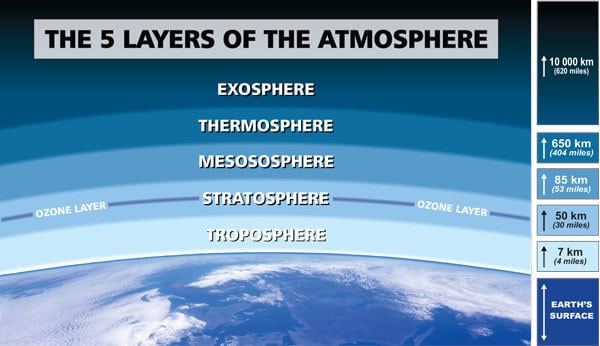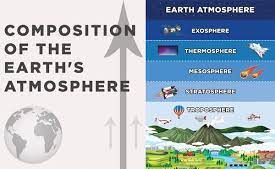World Geography : Atmosphere and its Composition & Layers. ( UPSC )
- The atmosphere is a layered gaseous cover that envelops the earth from all sides.
- The atmosphere is present on the earth by its gravitational force.
- The atmosphere of Earth protects life on Earth by warming the surface through greenhouse effect.
Composition of Atmosphere
The atmosphere is made up of three basic elements or components:
- Gas
- Water Vapor
- Aerosol
Gasses
- Constant Gases
- Nitrogen, oxygen and argon are the major stable gases, which account for 78.1, 20.9 and 0.9 percent respectively in the gaseous composition of the atmosphere.
- Variable Gases
- Variable gases include water vapor, carbon dioxide, ozone, hydrogen, helium, neon, xenon, krypton, methane, etc.
Water Vapor
- Due to this various forms and types of condensation and precipitation (Fog, frost, dew, hail, snow, water) found.
- In the warm and wet tropics it may account for 4 % of the air by volume, while ill the dry and cold areas of deserts and polar regions it may be less than 1% of air.
- Amount of water vapor decreases with altitude.
- It also decreases from the equator towards the poles.
- Water vapor absorbs parts of the insulation from sun and the thus reduces its amount reaching the earth’s surface.
- It also preserves the earth’s radiated heat.
- Water vapor absorbs heat during evaporation and release during condensation and precipitation.
- Released energy plays important role in producing tropical cyclones and thunderstorm.
Aerosols
- The particulate matter and liquid droplets suspended in the atmosphere are collectively called aerosols.
- It includes dust and ash emanating from volcanic eruptions, dust particles blown from plowing fields, sand particles blown from deserts, rock particles obtained from mechanical weathering of rocks, salt particles from the ocean surface, meteorite particles, organic matter ( bacteria, pollen, seeds etc.), smoke and soot etc.
Different layers of Atmosphere

Troposphere
- It is the lowest layer of the atmosphere, which is closest to the Earth.
- Tropos is a Greek word meaning mixture or disturbance.
- In the troposphere, 75% of the total molecular or gaseous mass of the atmosphere.
- All weather events occur in this layer.
- Its thickness is 8 km on the poles and 18 km on the equator.
- With increasing altitude in the troposphere, there is an average lapse of temperature at the rate of 6.50C per km (10 C for every 165 m) which is called normal lapse rate.
- The upper layer of the troposphere is called the troposphere.
Stratosphere
- It extends upto 50 kilometers.
- With increasing altitude, the temperature gradually increases.
- Most of the ozone gas of the atmosphere is found in the upper part of the stratosphere and it is is maximum at 22 km. height.
- Ozone blocks the harmful ultraviolet rays of the sun from reaching the earth’s surface.
- Ozone increases the temperature of the upper part of this layer by absorbing ultraviolet rays.
- Some rare clouds are visible in this layer, which is called ‘Mother of Pearls’ or Polar stratospheric cloud.
- Due to the absence of meteorological changes, this layer is ideal for aircraft flights.
- The boundary separating the mesosphere and the stratosphere is called the stratosphere.
Mesosphere
- It extends upto 80 kilometers.
- The temperature in this layer starts decreasing again with altitude.
- The minimum temperature (-1000C) in the atmosphere is recorded in the Mesosphere.
- The strongest winds are found in this layer.
- The Noctilucent clouds are found in the mesosphere.
Thermosphere / Ionosphere
- Thermosphere temperature rises very rapidly with increasing height.
- Ionosphere is a part of this layer.
- It extends between 80-400 km.
- This layer helps in radio transmission.
- Radio waves transmitted from the earth are reflected back to the earth by this layer.
- Person would not feel warm because of the thermosphere’s extremely low pressure.
- The International Space Station and satellites orbit in this layer.
- The Kármán line (or von Karman line) is an attempt to define a boundary between Earth’s atmosphere and outer space.
- It is situated at 100km above mean sea level.
Mechanism of heating and cooling of the atmosphere
- Radiation
- Direct heating of an object by thermal waves.
- Conduction
- The mechanism of transfer of heat between two adjacent parts of an object due to the difference in their temperatures is called conduction.
- It occurs due to molecular activity.
- The process of conduction plays very little role in heating the atmosphere, because the effect of conduction is only on the air near the surface and air is also not a good conductor of heat.
- Convection
- The transfer of heat due to the movement of substance is called convection.
- The lower layer of the atmosphere is heated by radiation or conduction by the earth.
- Air expands by heating. Its density decreases and it becomes lighter and rises up, due to the continuous rising of hot air, space is vacated in the lower layers of the atmosphere.
- To fill this void, cold air from above descends and thus convection currents are formed.
- Advection
- The horizontal transfer of heat by winds is called convection.
Tropic of Cancer
- The Tropic of Cancer is a parallel located at 23.5 degrees North of the equator.
- It most northerly circle of latitude on Earth at which the Sun can be directly overhead. This occurs on the June solstice, when the Northern Hemisphere is tilted toward the Sun to its maximum extent.
- North of the tropic are the subtropics and the North Temperate Zone.
- The Tropic of cancer passes through 17 countries, 3 continents and 6 water bodies.

Tropic of Capricorn
- Tropic of Capricorn is a parallel located at 23.5 degrees south of the equator.
- Tropic of Capricorn passes through 10 countries, 3 continents and 3 water bodies.

- The Tropic of Capricorn (or the Southern Tropic) is the circle of latitude that contains the subsolar point at the December (or southern) solstice.
- It is thus the southernmost latitude where the Sun can be seen directly overhead.
Subpolar Circles
- The 66.5 degree latitude in both the hemispheres are called the Subpolar circles.
- These latitudes are also called the Arctic Circle in the Northern Hemisphere and the Antarctic Circle in the Southern Hemisphere.
Note – The distance of the arc of 1^o latitudes is about 111 km. which differs from the equator to the poles due to the roundness of the earth.
Longitude
- The angular distance of a place which is to the east and west of the prime meridian (00 or Greenwich) is called longitude.
- It is measured in either of these two directions till 180^o.
- The equator is the circumference of a circle with angular divisions of 360^o.
- The distance at the equator of 1^o longitude is 111.32 km. which decreases towards the poles.
- At the poles it is 0 km.
- The number of longitudinal lines are also 360.
Prime meridian line/ Greenwich line
- The longitude line passing through the Greenwich place of England is called 00 longitude line or Greenwich line or Prime meridian line.
International Date Line
- All the longitudes in the East up to 180^o are called Eastern Longitudes and all the longitude from Greenwich Longitudes to the West are called West Longitudes.
- 180^o longitude is called the International Date Line.
- While crossing this line, one day is increased or decreased.
- One day is added for traveling west, while traveling in east direction is subtracted one day.
- Due to the fact that the International Date Line does not pass through any land area, it has been diverted near the Bering Strait, Fiji, Tonga, and other islands.
Earth’s movements
Rotation
- It’s turning on its axis.
- The earth completes one revolution on its axis from west to east in 24 hours.
- Because of this day and night are possible.
- During rotation , Day on the side of the Earth facing the Sun while on the opposite side there is night.
- Because the earth rotates from west to east the eastern to western part of the earth gradually faces the sun.
Revolution
- Earth makes one complete revolution around the Sun in an elliptical orbit in 365 days 5 hours 48 minutes 46 seconds.
Aphelion
- During this, on July 4, the Earth is at its maximum distance from the Sun in its orbit (152 million km.), which is called Aphelion.
Perihelion
- In contrast, on 3 January, the Earth is at the closest distance (147.3 million km) from the Sun. This condition is called Perihelion.
- Earth’s axis is inclined 23.5 degree to it’s normal.
- Therefore, during its revolution, sometimes one of its hemispheres comes near the Sun and sometimes it gets away from the Sun.
Equinox
- The time of the year when the Sun is vertical at the the equator is called the equinox.
- This situation occurs on March 21 and September 22.
- These are called Spring equinox and Autumn equinox respectively in the northern hemisphere.
Solstice
- It is a Latin word that means „stalled sun‟. It is a natural phenomenon that occurs twice every year.
- The Sun reaches the northern solstice (Tropic of Cancer) on 21st June and the Southern solstice (Capricorn) on 22nd December.
- These dates are called Karka Sankranti or Summer solstice and Makar Sankranti or Winter solstice respectively in the northern hemisphere.
Insolation
- Earth intercepts only one in two billion parts of solar radiation.
- This intercepted radiation is called Insolation.
- Energy from the Sun is released in the form of electromagnetic wave.
Solar Constant
- The amount of solar radiation energy received on per unit time per unit area on the surface of the Earth.
- It’s value is 1.94 calories per square cm per minute.
Factors affecting insolation
- Angle of incidence
- The higher the latitude, the less is the angle they make with the surface of the earth.
- The area covered by the vertical rays is always less than the slant rays.
- If more area is covered, the energy gets distributed and the net energy received per unit area decreases.
- Rotation of the earth on its axis
- The rotation of the earth on this inclined axis has a greater influence on the amount of insolation received at different latitudes.
- Duration of Day
- The longer the duration of the day, greater the insolation will be received.
- Variation in the amount of solar radiation
- These Student Notes: variations have periodic components, the main one being the approximately 11- year sunspot cycle.
- Sunspots are temporary phenomena on the photosphere of the Sun that appear visibly as dark spots compared to surrounding regions.
- When there is an increase in sun spots it leads to increase1 in the amount of solar radiation.
- Revolution of Earth around Sun
- The revolution path of the Sun by the Earth is elliptical.
- Therefore, on July 1, the Earth is at its maximum distance from the Sun. (Aphelion) while on January 1, the Earth is closest to the Sun(Perihelion).
- Transparency of the atmosphere
- Thick cloud hinders the solar radiation to reach the earth’s surface.
- Similarly, water vapor absorbs solar radiation resulting in less amount of insolation reaching the surface.
Heat Budget
- The mean annual temperature of the Earth’s surface remains constant because there is a balance between insolation and terrestrial radiation.
- This balance is called heat budget.
- Suppose 100 units of energy comes from the Sun.
- 6 units scattered by gas molecules and dust particles.
- Roughly 35 units are reflected back to space even before reaching the earth’s surface.


- The reflected amount of radiation is called the albedo of the earth.
- The remaining 65 units are absorbed as:

- Hence Earth receives 51 units of radiation which in turn radiates back in the form of terrestrial radiation.

- The details of 34 units radiation absorbed by atmosphere from terrestrial radiations are as under:

- Total units absorbed by the atmosphere are 48 (14 units insolation + 34 units Terrestrial radiation).
- Thus, the total radiation returning from the earth and the atmosphere respectively is





